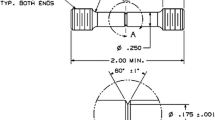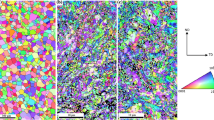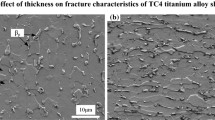Abstract
Commercially pure (CP) titanium has a unique behavior in that creep can occur at room temperature, which could be confused with hydrogen embrittlement under static loading conditions. This paper examines the effects of creep, hydrogen embrittlement, and notch sensitivity in Grade 2 CP titanium samples tested at room temperature. Fractographic characterization of the test samples was conducted to evaluate the operating failure modes and any notch effects.







Similar content being viewed by others
References
R. Boyer, G. Welsch, E.W. Colings, in Section II: Titanium Data Sheets on Commercially Pure and Modified Ti, ed. by S. Lampman. Materials Properties Handbook: Titanium Alloys (ASM International, Materials Park, 1994), p. 227, 235
G. Lutjering, J.C. Williams, Titanium: Engineering Materials and Processes, 2nd edn. (Springer, Berlin, 2007), pp. 275–276
R Ankem, T. Wilt, A Literature Review of Low Temperature (<0.25T mp ) Creep Behavior of α, α-β, and β Titanium Alloys, Center for Nuclear Waste Regulatory Analysis, September 2006, San Antonio, Texas
ASTM F519-10, Standard Test Method of Mechanical Hydrogen Embrittlement Evaluation of Plating/Coating Processes and Service Environments (ASTM International, West Conshohocken, 2010)
Timet Lab Report #639021, TiMetal 50A, Heat #HN0601, dated 12 December 2011
ASTM E8-08, Standard Test Methods for Tension Testing of Metallic Materials (ASTM International, West Conshohocken, 2008)
D.P. Dennies, Mechanical Property Test Results for Commercially Pure (CP) Titanium Plate, Exponent Report# 1204732.000 R0T0 1012 DD24, dated October 2012
D.P. Dennies, Strain Rate Data for Commercially Pure (CP) Titanium, Exponent External Memo 1204732.000 R0T0 0812 DD01, dated 2 August 2012
D.P. Dennies, 2000 Hour Creep and Fatigue Crack Growth Test Results for Commercially Pure (CP) Titanium Plate, Exponent External Memo 1204732.000 R0T0 0113 DD28, dated 28 January 2013
R.A. Kupkovits, R.W. Neu, Thermomechanical fatigue of a directionally-solidified Ni-base superalloy: smooth and cylindrically-notched specimens. Int. J. Fatigue 32, 1330–1342 (2010)
ASM Committee on Titanium, in Properties of Titanium and Titanium Alloys, Properties and Selection, Metals Handbook, 8th edn., vol. 1, ed. by T. Lyman (ASM International, Materials Park, 1961), p. 537
V.A. Joshi, Titanium Alloys: An Atlas of Structures and Fracture Features (CRC Press, Taylor and Francis, 2006). Figures 4.4 and 4.5 on p. 21
D.A. Meyn, E.J. Brooks, in Microstructural Origin of Flutes and Their Use in Distinguishing Striationless Fatigue Cleavage from Stress-Corrosion Cracking in Titanium Alloys. Symposium on Fractography and Material Science, STP 733, ASTM, 27–28 November 1979, pp. 5–31
E.R. Barta, R.R. Boyer, G.H. Narayanan, in Delayed Hydrogen Embrittlement of C.P. Titanium. ISTFA 1988—International Symposium for Testing and Failure Analysis, 1988, pp. 387–395
R.R. Boyer, W.F. Spurr, Characteristics of sustained load cracking and hydrogen effects in Ti–6Al–4V. Met. Trans. 9A(1), 23–29 (1978)
J.C. Chesnutt, N.E. Paton, M.R. Mitchell, in Fatigue Crack, Initiation and Propagation in Ti-6Al and Ti-6Al-4V. International Conference on Fracture, ICF5, Cannes, France, 1981, pp. 337–344
E. Tal-Gutelmacher, D. Eleizer, Hydrogen-assisted degradation of titanium based alloys. Met. Trans. 45(5), 1594–1600 (2004)
Author information
Authors and Affiliations
Corresponding author
Rights and permissions
About this article
Cite this article
Dennies, D.P., Kupkovits, R. Room-Temperature Creep Testing of Grade 2 CP Titanium Plate Using Notch Tensile Samples. J Fail. Anal. and Preven. 14, 437–442 (2014). https://doi.org/10.1007/s11668-014-9831-5
Received:
Published:
Issue Date:
DOI: https://doi.org/10.1007/s11668-014-9831-5




